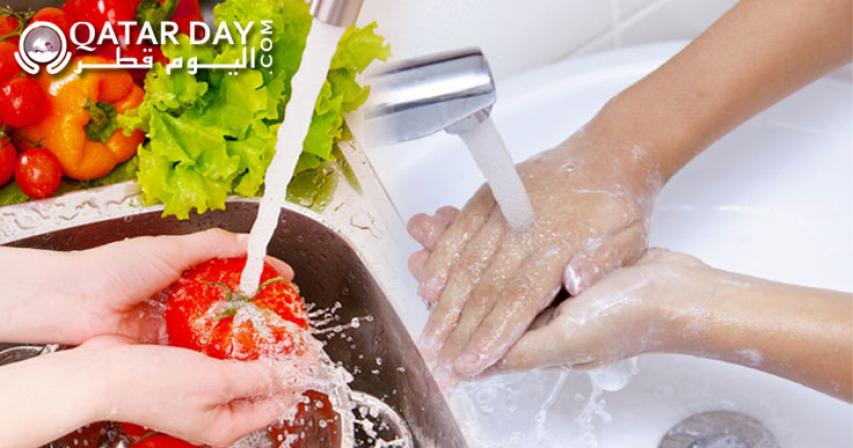Make sure you are hygienic while preparing food to avoid food poisoning and food-borne illnesses
- 4 years ago

To ensure your safety during this time of pandemic, make sure you are hygienic while preparing food to avoid food poisoning and food-borne illnesses.
Here are some health tips recommended by the Ministry of Public Health on safe food preparation:
• Keep your hands, equipment and food preparation area clean.
• Separate raw and cooked food. Use separate equipment (e.g. knives, cutting boards) for handling raw foods.
• Cook food thoroughly. Keep food at safe temperatures.
• Do not leave cooked food at room temperature for more than 2 hours.
• Keep foods that are supposed to be cold in the refrigerator. Use safe food. See “Five Keys to Safer Food”, Appendix 1, for more tips and information about the key recommendations
Food Borne Disease
• Adopting safe and clean food preparation methods can help to avoid food poisoning or food borne illness.
• Food borne diseases can be caused by consuming foods directly contaminated with microorganisms (e.g. salmonella in chicken) or food contaminated by diseased food handlers (e.g. typhoid, hepatitis A).
• Food poisoning can be especially severe for people with low immunity such as infants and the elderly.
Recommendations for Safe Food
• Thoroughly clean work surfaces, crockery, cutlery, cooking utensils and other equipment by using warm water with detergent.
Cleaning
• Thoroughly clean work surfaces, crockery, cutlery, cooking utensils and other equipment by using warm water with detergent. Make sure that utensils and other equipment are thoroughly dry before reusing them.
• Make sure to frequently wash and dry kitchen towels, sponges and cloths and to replace sponges regularly. You can reduce the risk of cross-contamination by using paper towels, which by being disposable cannot harbor and spread bacteria. Keep appliances such as microwave ovens, toasters, can openers, and blender and mixer blades free of residual food particles.
Purchase, Transport and Storage
• Do not purchase food items that have defective packaging, that are improperly sealed or that show signs of spoilage.
• Do not purchase or consume the contents of swollen or leaking cans and throw out the contents of any can if there is an unusual odor.
• Keep the purchasing of chilled and frozen foods until the end of a shopping trip to avoid warming or thawing of these products.
• Always read the label for storage instructions of purchased food items.
• Check the expiry date of packaged food before purchasing.
• When opening vacuum-sealed jars, make sure to listen for a popping sound, which indicates that the jar’s seal was intact.
• Make sure that areas used for food storage, such as cupboards, are clean and that foods are stored in food-grade containers away from chemicals.
• Store raw foods separately from readyto-eat foods in the refrigerator to prevent cross-contamination.
• Store frozen food in fully sealed packages to prevent “freezer burn” (i.e. the drying that occurs on the surface of a product and negatively affects its quality but not its safety).
• Store opened canned foods in the refrigerator, preferably not in the can.
• Store rehydrated foods in the refrigerator (e.g. bean).
• Store dried food in a sealed container and in a cool, dry place away from direct heat or sunlight.
• Make sure that the refrigerator temperature is 5 °C or lower.
• Cover all cooked foods and store them on a shelf above uncooked foods.
• Wrap raw meats or place them in a closed container and store them near the bottom of the refrigerator to prevent the dripping of meat juices on other foods.
• Regularly clean fridge and freezer shelves and doors and immediately clean up incidental spills.
• Make sure that frozen food is kept completely frozen. Regularly inspect dried food for insect infestation. Eat refrigerated leftovers and ready-to-eat meals within 1–2 days.
Preparation, Cooking and Serving
• Wash hands well with soap before starting to prepare food, giving attention to areas between fingers and under fingernails.
• After washing, thoroughly dry hands using a clean towel or a paper towel.
• Do not prepare food if suffering from a foodborne illness.
• Thoroughly clean chopping board and utensils used for cutting up raw meat in hot soapy water before using them for preparing foods to be eaten raw (e.g. vegetables, fruit).
• Keep vegetables separate from raw meat, chicken and fish while shopping, preparing and storing.
• Thaw foods in the refrigerator or a microwave oven, using the defrost setting.When thawing raw meat, make sure meat juices do not contaminate other foods, containers or utensils.
• Thoroughly wash fruit and vegetables under running water before peeling and cutting.
• Rub vegetables briskly to remove dirt.
• When preparing green salads (e.g. lettuce-based or parsley-based salads) make sure to thoroughly wash leaves as these items are usually harder to clean.
• Do not partially cook products and finish cooking them later; meat, fish and poultry must be thoroughly cooked before storage in the refrigerator.
• Carefully select meat intended to be eaten raw and to consume it immediately.
• Limit the time during which cooked foods such as stews and other meat and poultry dishes are left at room temperature (no more than 2 hours).
• Refrigerate milk-based deserts (e.g. mahalibia, custard) and consume them in 1–2 days after purchase or preparation.
• Never serve cooked food in plates and utensils that have held raw meat, poultry or seafood.
• When reheating food, heat it until it is “steaming hot” throughout.
• Boil unpasteurized milk before consuming it.
• Avoid raw (unpasteurized) milk or dairy products.
• Avoid raw or partially cooked eggs or foods containing raw eggs.
• Do not reheat foods more than once.
Source: Ministry of Public Health
Comments